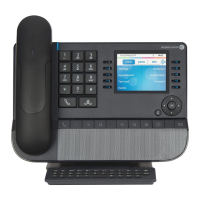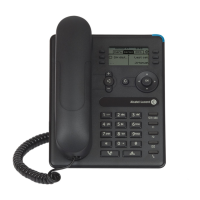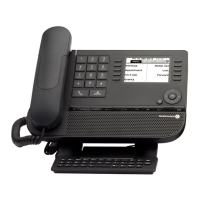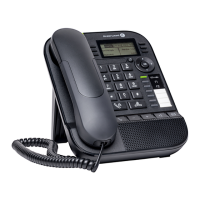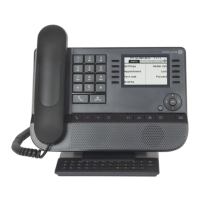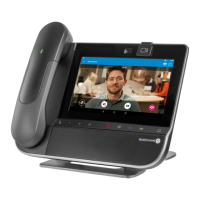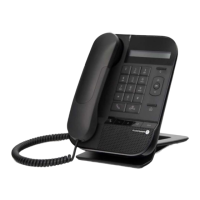Do you have a question about the Alcatel-Lucent 8068 and is the answer not in the manual?
Overview of the 8068 Bluetooth and Premium Deskphone features and specifications.
Details the features and specifications for the 8038 and 8039 Premium Deskphone models.
Information on the features and specifications of the 8028 and 8029 Premium Deskphone models.
Details the various connectivity options and ports available on different deskphone models.
Description of the phone's welcome screens, including their content and purpose.
Explanation of how to navigate through the phone's menus, options, and screens.
Explanation of the meaning and display of status and call icons on the phone screen.
Details the function and purpose of the phone's permanent feature keys.
Information regarding alphabetic keyboard variants and their usage for input.
Instructions for the installation and utilization of add-on modules for phone expansion.
Explanation of the call management screen, its interface, and available functions.
Details features, LED indicators, battery, and usage of the Bluetooth wireless handset.
Explanation of the different methods available for initiating a phone call.
Instructions on how to answer incoming calls using various methods.
Guidance on using the hands-free mode for calls when the terminal is idle or in progress.
How to activate and deactivate the loudspeaker feature during an active call.
Procedures for calling contacts by searching their names within the company directory.
Instructions for making calls using pre-programmed speed dial or feature keys.
How to filter incoming calls by utilizing the voice mailbox feature.
Methods for redialing the last dialed number or selecting from call history.
How to request an automatic callback when an internal number is busy.
Procedures for canceling a previously requested automatic callback.
How to answer intercom calls, which connect automatically in hands-free mode.
Instructions on sending DTMF signals during a conversation for automated systems.
How to mute your microphone to prevent the other party from hearing you.
How to initiate a second phone call while currently engaged in another call.
Procedures for answering an incoming second call while on an active call.
How to switch between multiple active calls, often referred to as broker calls.
Detailed instructions on how to transfer an ongoing call to another number.
How to transfer a caller directly to another correspondent's voice mailbox.
Steps for setting up and managing three-way conference calls with multiple participants.
How to place an active call on hold and later retrieve it on the same telephone.
How to park an outside call on hold and retrieve it from any telephone.
Procedure for intruding into an internal conversation, if authorized and permitted.
How to save a phone number to a call key during an active conversation.
Instructions on how to adjust the audio volume for the loudspeaker or receiver.
Step-by-step guide on how to initiate a "Meet me" conference call.
Instructions for participants to join an already established "Meet me" conference.
How to receive special ringing signals for calls directed to another number.
Procedures for answering operator calls when the operator is unavailable.
How managers can filter incoming calls to be routed to their assistants.
How to answer calls ringing on other extensions within or outside your group.
Handling incoming operator calls that ring on your telephone.
Information about hunting groups and how to make calls to them.
How to page an internal correspondent who does not answer their phone.
Procedures for answering a call that has been sent to your pager.
Remotely activating a correspondent's phone to speak via loudspeaker if they don't answer.
How to send predefined or custom written messages to internal contacts.
How to copy and send a voice message, with the option to add a comment.
How to send a recorded voice message to a list of specified recipients.
How to broadcast a message to multiple station loudspeakers within a broadcast group.
How to choose which types of calls (external, internal, all) to forward.
Steps to set up immediate call forwarding to a specified telephone number.
How to forward all incoming calls directly to your personal voice message service.
Procedures for accessing and managing recorded voice messages upon returning to your desk.
How to enable or disable the personal assistant feature for call management.
Configuration of the personal assistant to route calls to a single designated number.
How to forward incoming calls to your pager to ensure you are reachable.
How to forward calls to your current physical location using the "Follow me" function.
How to divert all calls received by a group to another internal telephone number.
Procedures for canceling all active call forwarding configurations.
How to cancel a particular, specific call forwarding rule.
How to automatically forward calls to another number when your line is busy.
How to activate the "Do Not Disturb" feature to make your terminal unavailable for calls.
How to leave a recorded message for internal callers that displays on their terminal.
How to access, read, manage, and respond to written messages received.
Configuration for receiving message notification on an alternate telephone.
How to charge the costs of outside calls to designated business account numbers.
How to check the cost of outside calls made by internal users from your terminal.
Steps for initializing and setting up the voice mailbox for the first time.
How to record and set a personal voice greeting for your voicemail.
Procedures for changing your personal access code for telephone and mailbox security.
How to adjust melody choice, ringer volume, silent mode, and meeting mode.
How to adjust the brightness of the phone's display screen and keys.
How to choose and set the default page displayed when the phone starts.
How to change the display language used on the telephone.
How to program speed dial keys on the personal (Perso) page.
How to remove or delete programmed speed dial keys from the personal page.
How to program the F1 and F2 function keys for direct call access.
How to delete or remove programmed F1 and F2 function keys.
Programming keys on specific models with LED and paper label indicators.
Deleting programmed keys on specific deskphone models.
How to set temporary or permanent reminders for appointments.
How to locate and identify the specific terminal number you are using.
Procedures for locking and unlocking the telephone for security purposes.
How to configure the audio jack for connecting headsets, hands-free kits, or speakers.
How to enable or disable the "Forced headset" mode for call handling.
Steps required to match a Bluetooth handset to the telephone for connectivity.
Guidance on operating the Bluetooth handset, including LED status indicators.
Steps to match a Bluetooth headset to the telephone, including PIN code entry.
Reference to user documentation for detailed usage of the Bluetooth headset.
How to remove a previously matched Bluetooth accessory from the telephone.
Information on details to prepare before contacting the system administrator.
Introduction to the role and function of agent sets within a call center environment.
Steps required to log into the ACD application as an agent.
Description of the information presented on the ACD application welcome screen.
Explanation of the four distinct operating statuses an agent set can have.
Procedures for changing the agent set's operating status via codes or function keys.
How an agent can change their personal access code for security.
How an agent can join or leave call center groups.
Steps for an agent to log out or close their session in the ACD application.
Role and capabilities of a supervisor within the call center environment.
How supervisors can monitor and access group voice mailboxes.
Critical safety warnings and mandatory precautions for the safe operation of the equipment.
Statements regarding regulatory compliance, including FCC, CE, and SAR exposure limits.
Overview of the 8068 Bluetooth and Premium Deskphone features and specifications.
Details the features and specifications for the 8038 and 8039 Premium Deskphone models.
Information on the features and specifications of the 8028 and 8029 Premium Deskphone models.
Details the various connectivity options and ports available on different deskphone models.
Description of the phone's welcome screens, including their content and purpose.
Explanation of how to navigate through the phone's menus, options, and screens.
Explanation of the meaning and display of status and call icons on the phone screen.
Details the function and purpose of the phone's permanent feature keys.
Information regarding alphabetic keyboard variants and their usage for input.
Instructions for the installation and utilization of add-on modules for phone expansion.
Explanation of the call management screen, its interface, and available functions.
Details features, LED indicators, battery, and usage of the Bluetooth wireless handset.
Explanation of the different methods available for initiating a phone call.
Instructions on how to answer incoming calls using various methods.
Guidance on using the hands-free mode for calls when the terminal is idle or in progress.
How to activate and deactivate the loudspeaker feature during an active call.
Procedures for calling contacts by searching their names within the company directory.
Instructions for making calls using pre-programmed speed dial or feature keys.
How to filter incoming calls by utilizing the voice mailbox feature.
Methods for redialing the last dialed number or selecting from call history.
How to request an automatic callback when an internal number is busy.
Procedures for canceling a previously requested automatic callback.
How to answer intercom calls, which connect automatically in hands-free mode.
Instructions on sending DTMF signals during a conversation for automated systems.
How to mute your microphone to prevent the other party from hearing you.
How to initiate a second phone call while currently engaged in another call.
Procedures for answering an incoming second call while on an active call.
How to switch between multiple active calls, often referred to as broker calls.
Detailed instructions on how to transfer an ongoing call to another number.
How to transfer a caller directly to another correspondent's voice mailbox.
Steps for setting up and managing three-way conference calls with multiple participants.
How to place an active call on hold and later retrieve it on the same telephone.
How to park an outside call on hold and retrieve it from any telephone.
Procedure for intruding into an internal conversation, if authorized and permitted.
How to save a phone number to a call key during an active conversation.
Instructions on how to adjust the audio volume for the loudspeaker or receiver.
Step-by-step guide on how to initiate a "Meet me" conference call.
Instructions for participants to join an already established "Meet me" conference.
How to receive special ringing signals for calls directed to another number.
Procedures for answering operator calls when the operator is unavailable.
How managers can filter incoming calls to be routed to their assistants.
How to answer calls ringing on other extensions within or outside your group.
Handling incoming operator calls that ring on your telephone.
Information about hunting groups and how to make calls to them.
How to page an internal correspondent who does not answer their phone.
Procedures for answering a call that has been sent to your pager.
Remotely activating a correspondent's phone to speak via loudspeaker if they don't answer.
How to send predefined or custom written messages to internal contacts.
How to copy and send a voice message, with the option to add a comment.
How to send a recorded voice message to a list of specified recipients.
How to broadcast a message to multiple station loudspeakers within a broadcast group.
How to choose which types of calls (external, internal, all) to forward.
Steps to set up immediate call forwarding to a specified telephone number.
How to forward all incoming calls directly to your personal voice message service.
Procedures for accessing and managing recorded voice messages upon returning to your desk.
How to enable or disable the personal assistant feature for call management.
Configuration of the personal assistant to route calls to a single designated number.
How to forward incoming calls to your pager to ensure you are reachable.
How to forward calls to your current physical location using the "Follow me" function.
How to divert all calls received by a group to another internal telephone number.
Procedures for canceling all active call forwarding configurations.
How to cancel a particular, specific call forwarding rule.
How to automatically forward calls to another number when your line is busy.
How to activate the "Do Not Disturb" feature to make your terminal unavailable for calls.
How to leave a recorded message for internal callers that displays on their terminal.
How to access, read, manage, and respond to written messages received.
Configuration for receiving message notification on an alternate telephone.
How to charge the costs of outside calls to designated business account numbers.
How to check the cost of outside calls made by internal users from your terminal.
Steps for initializing and setting up the voice mailbox for the first time.
How to record and set a personal voice greeting for your voicemail.
Procedures for changing your personal access code for telephone and mailbox security.
How to adjust melody choice, ringer volume, silent mode, and meeting mode.
How to adjust the brightness of the phone's display screen and keys.
How to choose and set the default page displayed when the phone starts.
How to change the display language used on the telephone.
How to program speed dial keys on the personal (Perso) page.
How to remove or delete programmed speed dial keys from the personal page.
How to program the F1 and F2 function keys for direct call access.
How to delete or remove programmed F1 and F2 function keys.
Programming keys on specific models with LED and paper label indicators.
Deleting programmed keys on specific deskphone models.
How to set temporary or permanent reminders for appointments.
How to locate and identify the specific terminal number you are using.
Procedures for locking and unlocking the telephone for security purposes.
How to configure the audio jack for connecting headsets, hands-free kits, or speakers.
How to enable or disable the "Forced headset" mode for call handling.
Steps required to match a Bluetooth handset to the telephone for connectivity.
Guidance on operating the Bluetooth handset, including LED status indicators.
Steps to match a Bluetooth headset to the telephone, including PIN code entry.
Reference to user documentation for detailed usage of the Bluetooth headset.
How to remove a previously matched Bluetooth accessory from the telephone.
Information on details to prepare before contacting the system administrator.
Introduction to the role and function of agent sets within a call center environment.
Steps required to log into the ACD application as an agent.
Description of the information presented on the ACD application welcome screen.
Explanation of the four distinct operating statuses an agent set can have.
Procedures for changing the agent set's operating status via codes or function keys.
How an agent can change their personal access code for security.
How an agent can join or leave call center groups.
Steps for an agent to log out or close their session in the ACD application.
Role and capabilities of a supervisor within the call center environment.
How supervisors can monitor and access group voice mailboxes.
Critical safety warnings and mandatory precautions for the safe operation of the equipment.
Statements regarding regulatory compliance, including FCC, CE, and SAR exposure limits.
| Camera | No |
|---|---|
| Speakerphone | Yes |
| Keys | Programmable keys |
| Audio Codecs | G.711, G.729, G.722 |
| Operating Temperature | 0°C to 40°C |
| Humidity | 10% to 90% non-condensing |
| Display Size | 3.5 in |
| Resolution | 64 x 128 pixels |
| Audio | HD audio quality |
| Ethernet | 10/100/1000 Mbps |
| Protocols | SIP |
| Power Supply | PoE |
| Headset | RJ-9 port |
| Bluetooth | No |
